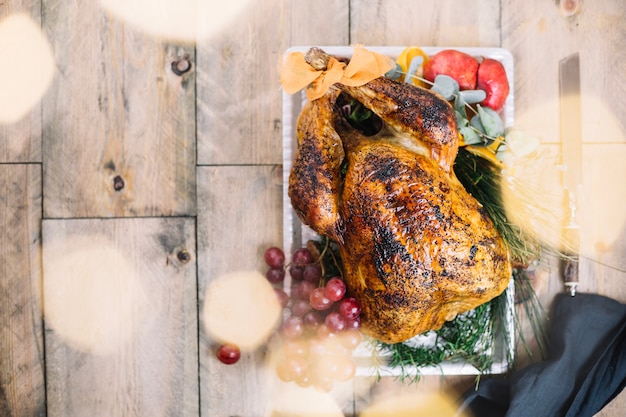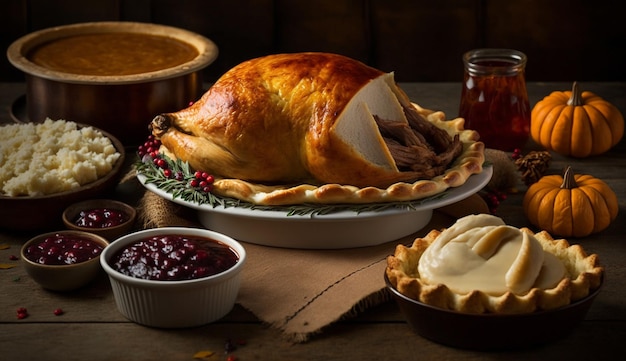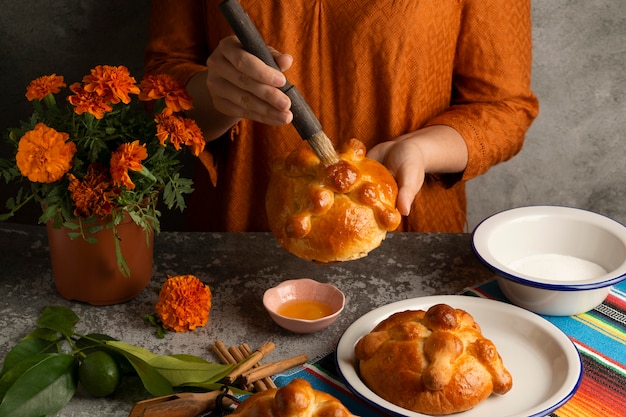Ah, the turkey. It's the undisputed king of the Christmas dinner table, the centerpiece of family gatherings, and the symbol of a festive feast. But let's be honest, a 14-pound turkey can be a bit daunting, even for seasoned cooks. It's a hefty bird, demanding a bit more attention and care than your average chicken. But fear not, my fellow food enthusiasts, for I'm here to guide you through the process, sharing my tried and true tips for achieving a perfectly roasted, juicy, and flavorful turkey. So, grab a cuppa, settle in, and let's embark on this culinary adventure together.
(Part 1) The Big Bird: A 14-Pound Challenge

A 14-pound turkey is no small feat. It's a magnificent creature, requiring a bit more time and attention to ensure it cooks evenly and to perfection. But with the right approach and a bit of patience, you'll be rewarded with a truly impressive centerpiece.
The Importance of Patience: A Key Ingredient
First and foremost, remember that this isn't a race. A 14-pound turkey needs a good amount of time to cook through properly, so don't rush the process. It's better to err on the side of caution and allow ample time for the bird to reach the right internal temperature. Trust me, you don't want to end up with a dry and disappointing turkey.
Choosing the Right Bird: Setting the Stage for Success
The quality of your turkey will have a significant impact on the final result. When choosing a 14-pound turkey, I always opt for a fresh, free-range bird. These turkeys are typically more flavorful and have a more tender texture, thanks to a more natural diet and less confinement. If you're going for a frozen turkey, make sure it's completely thawed before you start cooking. Don't even think about trying to roast it from frozen!
Prepping the Bird: Preparing for the Roast
Once you've got your beautiful bird, it's time to give it a good prep. Start by rinsing it thoroughly inside and out, making sure to remove any giblets or neck from the cavity. These bits can be saved for making a rich gravy, but for roasting, they're best left aside. If you're feeling adventurous, you can stuff the cavity with herbs and aromatics for added flavor. Just remember, don't overstuff the bird! You want to allow room for the juices to circulate and prevent the stuffing from becoming soggy.
(Part 2) The Roast: Setting the Stage

With your turkey prepped and ready, it's time to set the stage for the main event – the roast.
The Right roasting pan: A Culinary Canvas
You'll need a roasting pan that's big enough to hold the turkey comfortably, with enough room for the juices to collect at the bottom. I prefer to use a large roasting pan with a rack, which allows air to circulate around the bird for more even cooking. The rack also helps to elevate the turkey, ensuring that the bottom doesn't get soggy.
Temperature and Timing: A Culinary Dance
The general rule of thumb for roasting a turkey is to cook it at 325°F (160°C). But remember, the cooking time will vary depending on the size of your bird. A 14-pound turkey will typically take around 3 to 4 hours to cook. However, I always rely on a meat thermometer to ensure the turkey is cooked through to perfection. Insert the thermometer into the thickest part of the thigh, making sure not to touch the bone. The internal temperature should reach 165°F (74°C) for a fully cooked turkey.
Basting: Keeping It Moist and Flavorful
Basting is key to achieving a moist and flavorful turkey. Every hour or so, carefully pour the pan juices over the turkey. This helps to keep the skin crispy and the meat tender. You can also add a bit of butter, herbs, or even a splash of wine to the pan juices for extra flavor. Just be careful not to over-baste, as this can make the skin soggy.
(Part 3) The Side Show: Accompanying the Star

A turkey deserves a supporting cast of delectable sides, just as much as a leading actor needs a talented ensemble. Here are some of my favorite side dishes that complement a roasted turkey beautifully.
The Best Turkey Sides: A Festive Ensemble
No Christmas dinner is complete without the classics. Think roasted potatoes, crispy brussels sprouts, sweet carrots, and a comforting stuffing. And let's not forget a vibrant side salad to add a touch of freshness and color to the table.
Roasted Potatoes: The Golden Standard
Roasted potatoes are a staple for a reason. They're simple, versatile, and always a crowd-pleaser. Simply toss them with olive oil, salt, pepper, and a sprinkle of rosemary, then roast them in the oven along with the turkey. The potatoes will absorb the turkey's drippings, adding depth of flavor and a golden-brown crust.
Brussels Sprouts: A Crunchy Delight
Don't shy away from Brussels sprouts! Roasting them brings out their natural sweetness and gives them a lovely, crunchy texture. Try tossing them with olive oil, bacon bits, and a touch of maple syrup. This sweet and savory combination will transform Brussels sprouts into a delicious side dish that even the most skeptical eaters will enjoy.
(Part 4) Resting: The Final Act
So, the turkey is cooked to perfection, and the sides are ready to go. But before you start carving, there's one crucial step that many people overlook: resting.
Why Resting is Crucial: A Moment of Relaxation
Allowing the turkey to rest for at least 30 minutes before carving is essential. It gives the juices a chance to redistribute throughout the meat, resulting in a more tender and flavorful bird. Think of it as a moment of relaxation for the turkey before the grand finale.
Carving Tips: A Masterful Presentation
After resting, it's time to carve the turkey. Use a sharp carving knife and work slowly and carefully. Start by removing the legs and thighs, then move on to the breasts. If you're feeling adventurous, you can try carving the breast into thin slices for a more elegant presentation.
(Part 5) The Leftovers: A New Beginning
Now, let's be honest, there will inevitably be leftovers. But don't despair! Leftover turkey is a blank canvas for culinary creativity.
Turkey Sandwich: A Classic Comfort
Who doesn't love a good turkey sandwich? Use leftover turkey, stuffing, cranberry sauce, and some mayonnaise on crusty bread for a satisfying lunch. It's a simple yet delicious way to enjoy the flavors of your Christmas feast.
turkey soup: A Cozy Comfort
Transform your leftover turkey into a hearty and comforting soup. Combine turkey, vegetables, and broth for a warm and satisfying meal. This is a great way to use up leftover turkey and vegetables, and it's perfect for a cold winter evening.
turkey pot pie: A Savoury Treat
Combine leftover turkey with gravy and vegetables for a delicious pot pie. Top it with a flaky crust, bake until golden brown, and you've got a satisfying and savory dish that's perfect for a family dinner.
(Part 6) The Turkey Timeline: A Visual Guide
Here's a visual guide to help you navigate the turkey roasting process:
| Time | Task |
|---|---|
| 2-3 hours before cooking | Thaw the turkey (if frozen) |
| 1 hour before cooking | Preheat oven to 325°F (160°C) |
| 1 hour before cooking | Prep the turkey |
| 3-4 hours | Roast the turkey |
| 30 minutes | Rest the turkey |
| 15-20 minutes | Carve the turkey |
(Part 7) Troubleshooting: When Things Go Wrong
We've all been there. The turkey isn't cooking evenly, the skin is getting too brown, or something unexpected happens. Don't worry, it's all part of the process.
Uneven Cooking: The Fix
If your turkey isn't cooking evenly, you might need to adjust its position in the oven. Rotate the turkey halfway through the cooking time. This ensures that all sides are cooked properly and prevents one side from getting overcooked while the other side is still undercooked.
Overly Brown Skin: The Solution
If the skin is getting too brown, tent the turkey with foil to prevent further browning. Just be sure to remove the foil for the last 30 minutes of cooking to allow the skin to crisp up.
(Part 8) turkey tips: From the Experts
Over the years, I've picked up some valuable tips from seasoned turkey roasters that have made a world of difference in my own roasting adventures.
Brining: Unlocking Juiciness
Brining is a great way to keep your turkey moist and flavorful. It involves soaking the turkey in a salt-water solution for several hours, which helps to retain moisture and adds a subtle flavor. If you're aiming for the most tender and juicy turkey, give brining a try.
Butterflying: For a Faster Roast
If you're short on time, try butterflying the turkey. This involves cutting the breastbone and flattening the bird, which allows it to cook much faster while still achieving a delicious result. This technique is perfect for those who don't have a lot of time to spare but still want a beautiful and flavorful roasted turkey.
(Part 9) FAQs: Your Turkey Questions Answered
Let's address those lingering questions you might have about roasting a 14-pound turkey.
1. How do I tell if my turkey is cooked through?
The best way to check if your turkey is cooked through is to use a meat thermometer. Insert the thermometer into the thickest part of the thigh, making sure not to touch the bone. The internal temperature should be 165°F (74°C).
2. What should I do if my turkey is overcooked?
Don't panic! Overcooked turkey might be a bit dry, but it's still edible. You can try adding a little bit of broth or gravy to help moisten it. The key is to be strategic about incorporating the additional liquid to rehydrate the meat without making the dish too watery.
3. How do I keep my turkey moist?
Basting is crucial for keeping your turkey moist. Pour the pan juices over the turkey every hour or so. You can also add a bit of butter or herbs to the pan juices for extra flavor.
4. What do I do with the turkey giblets?
You can use the giblets to make a delicious gravy. Simmer them in broth with vegetables and herbs. Or, you can simply discard them.
5. What if my oven is too small for a 14-pound turkey?
If your oven is too small, you can try roasting the turkey in two parts. Roast the legs and thighs separately from the breast. This allows you to ensure even cooking for each part of the turkey.
(Part 10) The Final Word: A Roasting Triumph
There you have it, my comprehensive guide to roasting a 14-pound turkey. Remember, it's all about patience, practice, and a bit of love. With the right approach, you'll create a truly impressive feast that your family and friends will savor. So, go forth, my friend, and conquer the turkey. You've got this!
Everyone is watching

How to Cook Frozen Lobster Tails Perfectly: A Step-by-Step Guide
RecipesLobster. Just the word conjures up images of lavish meals, special occasions, and a taste of luxury. But let's...

Pork Fillet Cooking Time: How Long to Cook It Perfectly
RecipesPork fillet, or tenderloin as it's sometimes called, is a real favourite in our house. It's so versatile, and...

Pigs in a Blanket Cooking Time: How Long to Bake for Perfect Results
RecipesAh, pigs in a blanket. Just the name conjures up images of those delightful little parcels of crispy pastry en...

The Ultimate Guide to Cooking Delicious Frankfurters
RecipesLet's face it, we all love a good frankfurter. It's a classic, simple, and always satisfying. But let's be rea...

Wolf Meat Recipes: A Guide to Cooking Wild Game
RecipesLet's be honest, you don't see wolf meat at your local butcher shop every day. It's a bit of a wild card, but ...
